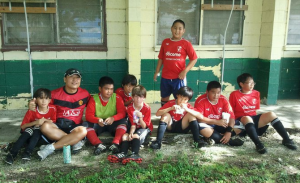Food Scientist/Food Safety Program Leader

Institution: Northern Marianas College-Cooperative Research, Extension, and Education Services
Education:
BA, Biology, Kyungsung University, Korea
MS, Cell and Molecular Biology, Kyungsung University, Korea
Ph.D., Food Science, Mississippi State University
What early experiences influenced you to work in childhood obesity prevention?
Before being involved in Children Healthy Living program, I did not have much experience in childhood obesity and nutrition area. However, I have always thought that the childhood obesity is one of the critical issues in public health. Nowadays many food scientists are studying healthy foods for well-being and preventing childhood obesity. I am interested in research on healthy foods with low fat and high fiber that may lower obesity. Of course, the food should be tasty as well.
What advice would you give high school or undergraduate students that want to get into your professional field?
Developing new food products is fun. Imagine sweet and smooth chocolate that does not make you obese or a pill that gives soldiers enough energy to sustain themselves for several days. Fighting food poisoning microorganisms is another important field for young students to consider for their future career. Everyday many people get sick and dying all over the world by foodborne diseases. Besides, food is one of the most important necessaries of humans
What do you think the Pacific Islanders will gain from the CHL program?
The CHL program is already making a positive impact upon health in the CNMI. People are starting to realize why childhood obesity prevention is so important and how we can decrease it. That is why local communities strongly support the CNMI CHL team. I believe the CHL program can build a successful intervention program for our region and will improve children’s healthy living. In addition, the CHL program is training young professionals through the CHL training program and they will work for the public health in the CNMI.
What does an average day look like for you?
Every morning I start my day checking e-mails. These days, 70% of my email is CHL-related. Then I check iCalendar for my daily schedule. If there is anything that I have to do with the CHL program, I talk to the CHL site manager and administration. Sometimes I have meetings with my food safety program staff for my research projects and with local clients for value-added product development. This is my average day in Saipan when I am not traveling.
What advice would you give caregivers of young children about best lifelong health practices related to CHL-connected efforts?
Like Rachael LG in Guam mentioned, lead by example is a key. All caregivers should be a good example to young children since young children’s health practices could be lifelong health habits. And we must remember that children are the mirrors of adults. They follow adults’ examples regardless of bad or good practices.
What do you love about the CNMI?
I love the clouds, wind, geckos, kingfishers, and the plumeria in the CNMI. But most of all, I love people in the CNMI. That is why I am transformed into a Chamorro mentally and physically.
